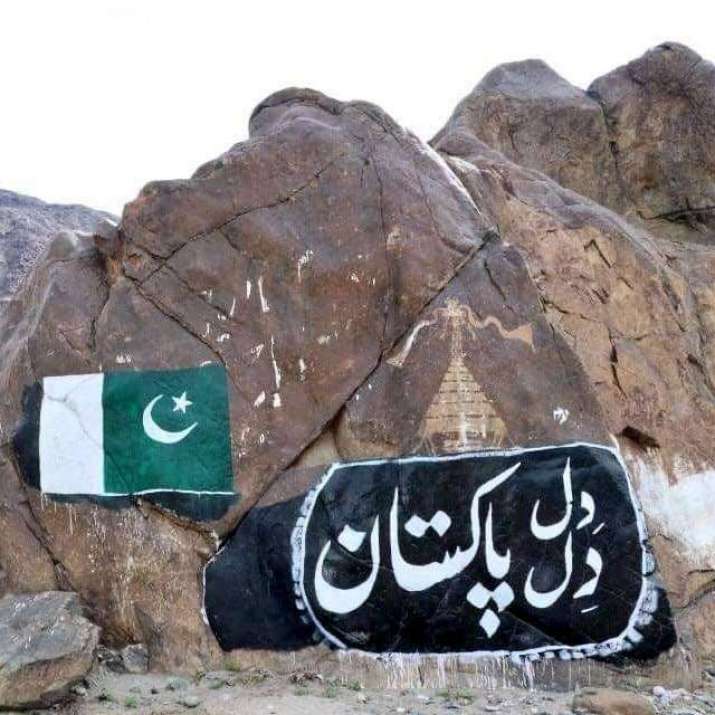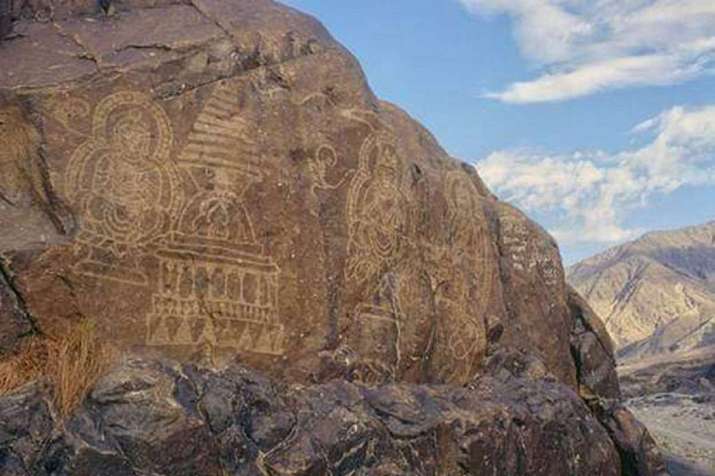NEWS
Ancient Buddhist Rock Carvings in Pakistan Vandalized
 From twitter.com
From twitter.comIn the Gilgit-Baltistan region of Pakistan this week, several priceless ancient Buddhist rock carvings have been damaged with paintings, including one of Pakistan’s national flag. The carvings were already under threat from a Chinese-led dam development underway in the same valley. According to residents of the area, the vandalism may be a response to attempts to halt the dam project.
The rock carvings are in the Chilas area of Pakistan, near the ancient Indus river, known to historians for the ancient civilizations that sprung up around it, including Harappa and Mohenjo Daro, each dating back several millennia. Today the area is part of the greater Jammu-Kashmir region, where Pakistan and India maintain an uneasy military truce along disputed borders.
Discovered last week by local residents, the vandalism is believed to be a result of protests against the Diamer-Bhasha Dam project, funded by China Power and the Frontier Works Organization, which is working with a division of the Pakistan Army. If completed, the project would submerge the Buddhist historical works along with some 50 villages in the area.
 Buddhist rock art in the area dating to around the eighth century CE. From thestatesman.com
Buddhist rock art in the area dating to around the eighth century CE. From thestatesman.comResidents have taken to social media to protest the dam, with one saying: “The wealth of Indic history spanning over millennia will soon be submerged under waters of the dam in Gilgit Baltistan.” Another resident, Araib Ali Baig, wrote: “The art of rock carving is present in all regions of Gilgit Baltistan, mainly in the districts of Diamir, Hunza, and Nagar and Baltistan. Speaking specifically of Baltistan, these engravings can be seen on former settlements and popular old routes along the Indus and Shyok.” (The Statesman)
The rock carvings are several centuries old, likely dating to the later years of the spread of Buddhism along the Silk Road, first toward China and then to Tibet through the high mountain passes of the Himalaya. Early records suggest the seventh or eighth centuries as the date for the introduction of Buddhism in this area, which later became part of the greater Tibetan empire. Buddhism dominated the sparsely populated mountainous region until the 15th century, when Islam arrived. Since then, Buddhism has died out in Gilgit-Baltistan, but continued in neighboring Ladakh, which is today part of India.
During a recent visit to Leh, capital of Ladakh, His Holiness the Dalai Lama noted the importance of the ancient Buddhist heritage in Ladakh and neighboring regions, and called for its preservation.
While not Buddhists themselves, area residents recognize the Buddhist artwork for its historical value and its tourist potential. “Yes, these sculptures belong to Buddhism. They can attract millions of tourists across the globe. Irrespective of religion we should preserve this ancient heritage,” commented another resident. (The Statesman)
On 13 May, the Pakistani government signed a deal for 442 billion Pakistani rupees (US$5.8 billion) to commence construction of the dam after years of delays.
See more
Chinese built dam to submerge engraved heritage rocks of Buddhism in Gilgit Baltistan (The Statesman)
Buddhist rock carvings vandalised by Islamists in Gilgit-Baltistan, Pakistan flag painted on ancient artwork (The Statesman)
Related news from Buddhistdoor Global
Korea’s Jogye Order to Establish Buddhist Temple in Pakistan
Thai Buddhist Delegation Visits Heritage Sites in Pakistan
Excavation of Buddhist Site Mound Dillu Roy to Begin in Pakistan
2000-Year-Old Buddha Statue from Pakistan on Loan to Swiss Museum
Shah Allah Ditta Buddhist Caves in Pakistan in Need of Preservation
Related features from Buddhistdoor Global
Pakistan, Sri Lanka, and Nepal: A New Bloc of Buddhist Communication?
Diplomacy, Heritage, and Cultural Pride: Reviving the Buddhist Legacy of Islamic Pakistan
Self-reflection in Kashmir














